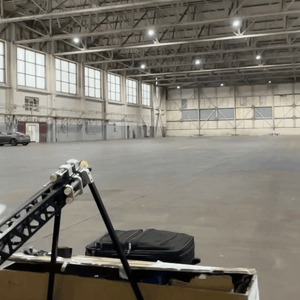Access Ai.rplane for free by clicking here.
In most engineering there is a large gap in both effort and time between idea and reality. This applies equally for hobbyists and professionals and across most industry verticals. It is especially true for aerospace — the physics of flight being complicated!
You have creativity and ideas, but even with lots of computing power thrown at the problem, it can take days or weeks to evaluate a single design and get that first valuable piece of feedback.
But what if you had an idea and there was a way for you to create something fast? What if tech could actively help you? If you could train a deep learning model on a range of designs, stir in some aerodynamics, add a pinch of structural mechanics, shake it about, and ask it to generate new designs, what might it create?
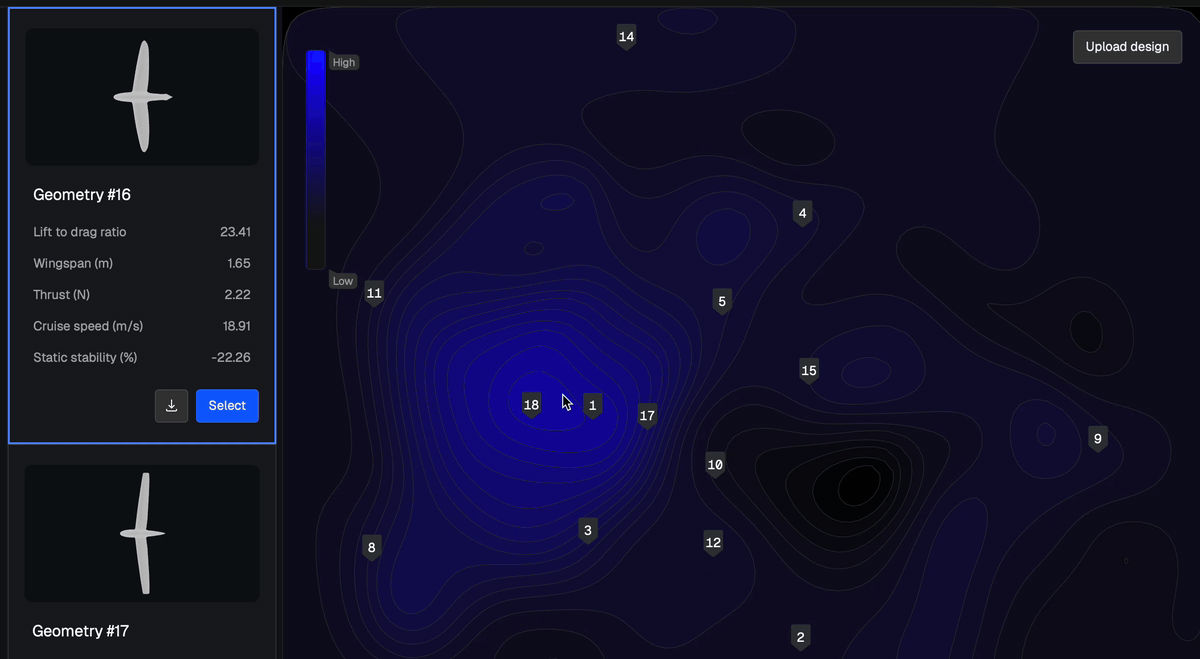
PhysicsX builds deep learning models for doing physics very, very fast. Ai.rplane is a technology demonstrator, based on our latest Large Geometry Model (LGM-Aero) which does exactly that. You can use it to generate shapes and predict aerodynamics, stability, and structural performance several orders of magnitude faster than with traditional numerical simulation approaches. The technology behind it is a combination of:
- Our latest Large Geometry Model for Aero for representing shapes very efficiently, and in a way that makes generating new and novel designs incredibly easy
- Deep learning models for solving hard physics like aerodynamics and structures
- Bayesian methods for quantifying uncertainty and advanced optimisation
Whether you're an RC hobbyist, a tech enthusiast, or an aerospace engineer keen for a glimpse of the future there’s something in Ai.rplane’s latent space waiting for you.
What you can do with it
- Filter the aircraft design space to match your engineering requirements, such as the payload weight you need to carry
- Visualise the design space based on performance parameters such as lift-to-drag ratio and stability
- Select one of the suggested designs as a starting point, or click anywhere else in the design space to generate something completely unique
- Use our AI-based deep learning model to predict pressure fields on the design in seconds. If you were doing this work using a traditional tool such as a Computational Fluid Dynamics (CFD) solver the same result could take you hours
- Tweak and modify the design to deepen your understanding - results are recalculated instantly
- Automatically generate an optimal structural skin to carry the calculated loads acting on your design, and plot the stress that it sees
- Upload your own aircraft design. We then plot it in the design space, predict its aerodynamics, and generate a structure to support flight
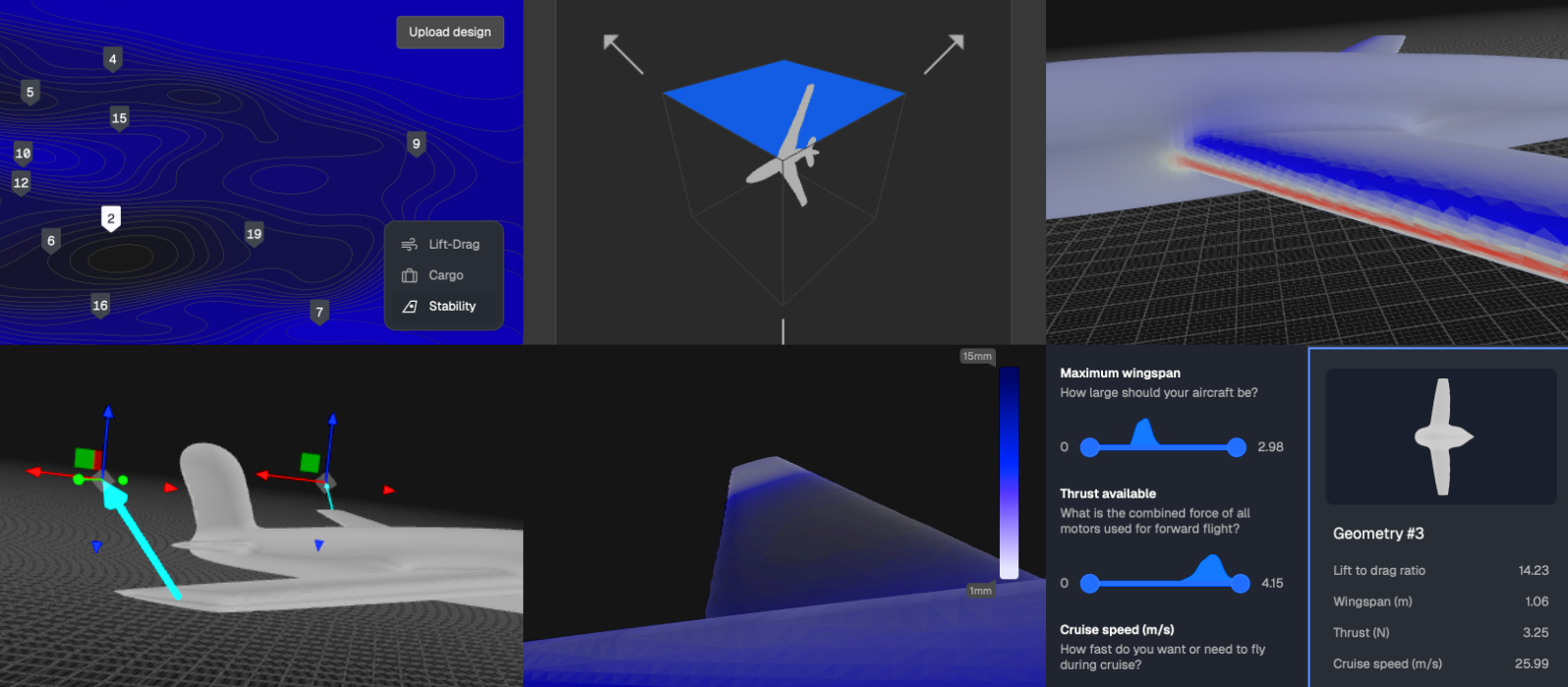
How Ai.rplane works
Built on LGM-Aero
Ai.rplane is built on ‘LGM-Aero’, a generative AI model for aeroelastic applications that has been subsequently fine-tuned for aerostructures. LGM-Aero is our latest Large Geometry Model (LGM) and is available on the PhysicsX AI engineering platform.
The model is trained on a combination of mesh-based open-source datasets and datasets we have generated ourselves from scratch including:
- 25+ million 3D shapes, corresponding to tens of billions of mesh elements, so that the model learns to construct plausible geometry.
- Tens of thoustands of Computational Fluid Dynamics (CFD) and Finite Element Analysis (FEA) simulations so that the model learn to predict aircraft physics - like lift, drag, flight stability and structural stress.
LGM-Aero generates geometry while simultaneously assessing physics as a zero-shot learner - entirely sidestepping numerical simulation - and enabling extremely fast search over novel design spaces. That said, there is the matter of generalization and if your geometry is a bit rogue, the model isn’t going to do a good job predicting its aerodynamics. However for shapes that vaguely resemble aircraft the results from this model are typically very comparable to traditional simulations. Each result comes with a baked-in uncertainty so that you can get a sense for how confident the model is, and all results will arrive within seconds rather than hours.
We have a technical blog post and paper in progress about how these models work under the hood. Check back here soon for the link.
The design space
The aircraft ‘design space’ which we plot results on is not a pre-computed grid of designs. Instead, we use LGM-Aero to interpolate between designs in our training data to surface novel shapes that best match your requirements. Often we will be creating an entirely bespoke new geometry just for you.
During training, the deep learning model learns an abstract 'signature' for each design it sees. This signature is a unique set of 512 numbers but we compress the 512 numbers down to a two-dimensional map. The technical term for this map in Ai.rplane is a 'latent space'.
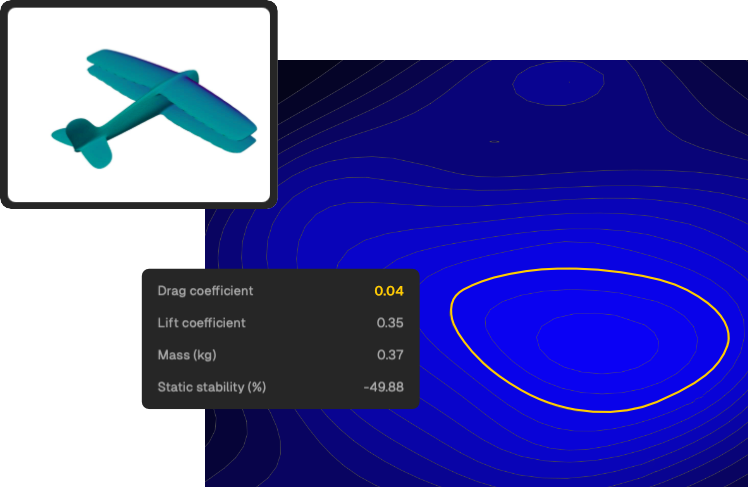
The contour lines of the latent space represent any of a series of performance parameters such as lift-to-drag ratio, stability, and cargo weight. You can preview what a design in a certain part of the latent space will look like by clicking and selecting ‘Generate design’. A few seconds later a new pin will appear in the latent space along with its corresponding shape and performance characteristics.
Tweak your design
You can click ‘Select’ on any result in the latent space to examine it further. LGM-Aero will display detailed pressure field results within a matter of seconds. This will help you get an intuitive feel for which parts of the design are working well and which parts are working less well.
You can improve your design by using morphing tools to make tweaks to the mesh and receive instantly updated results. Simply select a point on the mesh, choose whether the change will have a local or a global effect, and drag to move the point.
Structures
A major capability unlocked by moving physics simulation to AI inference - from numerical solutions - is the ability to run very fast optimisation loops. We use this superpower in Ai.rplane to generate and optimise a structural skin for each design that can carry the external loads. Once this is in place you can also view the stress each part of the design is under and look out for hotspots that may need additional refinement.
Our underlying model has been trained on multiple types of physics simultaneously. Our results are effectively the equivalent of combining a CFD workflow with an FEA workflow.
Export
Once you are happy you can export your favourite design to an STL file. Feel free to validate it using traditional calculation methods, or to print it on a 3D printer to confirm that it actually flies!
Imagine how long it would have taken you to get to this point using CAD, CFD and FEA…
Meet the team
PhysicsX is made up of engineers, scientists, designers and developers of all sorts. And we are all builders at heart! We’re still a relatively small team setting out to change how engineering is practiced across some of the most important industries of our time, starting with some of the highest complexity engineering problems in those industries — because that’s where AI stands to make the biggest difference. It’s an absurdly audacious mission and yet we’re making progress - which we measure by our customers’ progress. And we are buoyed up and fortified by a fast-growing community of engineers and scientists across academia and industry that share the same vision for AI disrupting engineering and engineering tooling.
If you’re interested in joining our team, visit our Careers page to explore open positions. Don’t see a role posted? We would love to learn more about you and your experience. Feel free to introduce yourself and send us a CV at info@physicsx.ai.
And to find out if we could help you on your most important engineering challenges please contact us.
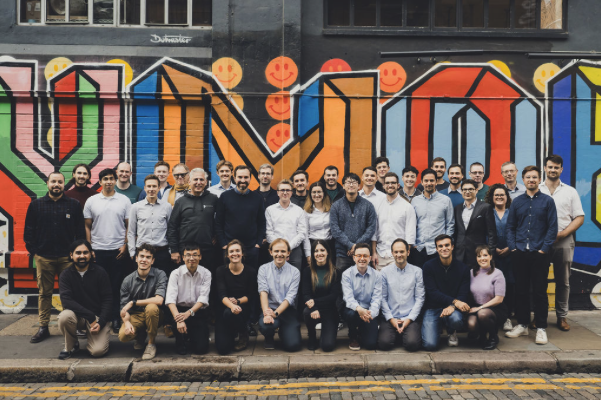
Several 3D-printed aircraft models were harmed whilst making this app!
